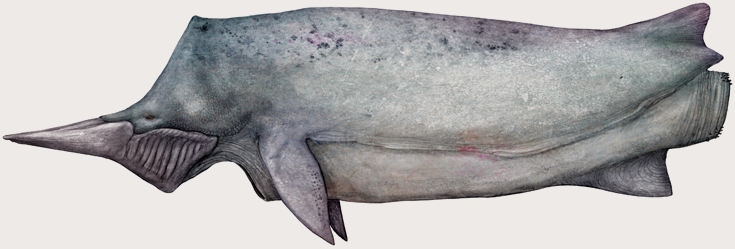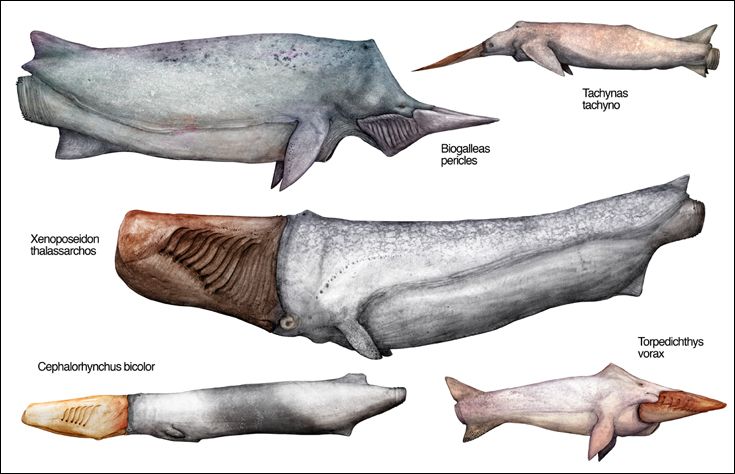Cardiocetes
The fantastic conclusion of the evolutionary adventure that began with the Jetocetes and their relatives, the Cardiocetes are the masters of aquatic jet-propulsion on Snaiad. Like their Jetocete ancestors, the Cardiocetes have split and looped half of their second-head digestive tracts through their first heads and have a separate, specialized tract of the gut adapted solely for propulsion. Unlike the Jetocetes, this jet tube is supplemented by a hugely powerful, heart-like pump in Cardiocetes, earning them their scientific name as “heart-whales.” These organs, arranged in different species either as singular, gigantic pumps (Monocardia,) or in bundles like engine cylinders, (Polycardia,) need a lot of energy to work. Thus, it is not surprising that the majority of Cardiocetes have become filter feeders, endlessly skimming food off the plankton-rich currents of the open oceans.

Species: Xenoposeidon thalassarchos
Common Names: Big Fish, Giant Jetwhale, Poseidon. Bahamut.
Size: More than 40 meters in some cases.
Habitat: More common in the oceans of the Northern Hemisphere, but encountered worldwide.
Perhaps the largest animal on Snaiad, Xenoposeidon thalassarchos is a truly awe-inspiring beast. A member of the Monocardiac Cardiocetes, it has a single, titanic jet-heart at the end off its propulsive gut. While this organ helps greatly during bursts of speed, Xenoposeidon also uses waves of its huge body to swim along. These creatures endlessly follow the plankton-rich sea currents in Snaiadi oceans, literally living in streams of small animals and plants. Their cavernous beaks have a system of ingenious shunts, inlets and holes that allows them to filter the water for nutrients with ease. The holes along their beaks expel the filtered water, but they also perform a role in the reproductive lives of these animals. During mating, the males release an extremely thick, ink-like substance in great quantities from these holes. The females willingly bathe themselves in this soupy mix of sperm, and a while later get pregnant with young. During pregnancy, the developing young completely occupy the females’ mouths and the mothers derive their nutrients from plankton ingested by their jet tracts and jet-hearts, which used to be parts of their digestive system to begin with.
The name of Xenoposeidon is the same as that of a sauropod dinosaur from Earth. However, revised nomenclature rules arranged in the light of the planets’ separate natural histories allow for such name overlaps. If two or more organisms from different worlds are to be mentioned together in a scientific publication, a letter prefix before their names will suffice, such as (S)-Xenoposeidon, (T)-Xenoposeidon, (ש)-Xenoposeidon and (J)-Xenoposeidon from Snaiad, Earth and two other realms respectively.

Species: Cephalorhynchus bicolor
Common Names: Puffinwhale, Duck beast, Orange Heartwhale.
Size: 15 meters.
Habitat: Great Antipodean Ocean.
This colorful Monocardiac Cardiocete is so similar to Xenoposeidon species in terms of anatomy and behavior that it is debatable whether it really needs to be classified in a separate genus. Like Xenoposeidon, it is a passive filter-feeder with a single jet-heart. Its striking black-and-white color scheme, as well as its brightly orange head makes it a favorite of sea-watchers around Aviv, Alcaat and Elyat, the only settlements along its habitat.

Species: Biogalleas pericles
Common Names: Prownose Heartwhale, Shelf-Whale, Mutur.
Size: Up to 24 meters.
Habitat: All southern oceans, frequently ventures into the seas of the Two Lands, Midland and Oroland.
These large Cardiocetes are usually heard rather than seen underwater with their throbbing jet-beats reverberating across the waves. While they superficially look like the Monocardiac giants of the north, the construction of their mouths, multiple jet-hearts and even their feeding strategies set them apart as Polycardiac Cardiocetes, albeit huge and filter-feeding ones. Their filter-feeding is more like taking bites out of the giant plankton swarms, rather than passively swimming through them like their Monocardiac cousins. They have also secondarily tuned down the engine-like multiple jet-hearts of their lineage, pumping along at a leisurely pace instead of the jet-ski-like frenzy of their smaller relatives.
This species is readily identifiable through its tapering, ram-like snout extension, used in a variety of social activities such as friendly snout-rubbing with members of the same pod, sexual displays for potential mates, and outright ramming against intruders or rowdy males. There are at least four separate species of Biogalleas in Snaiadi oceans, with one, B. polaris, also widespread in the Northern Hemisphere.

Species: Tachynas tachyno
Common Name: Swordfish.
Size: Up to 3 meters long including beak.
Habitat: Present in almost all oceans and seas.
Not all Polycardiac Cardiocetes are sluggish giants like Biogalleas. In fact, most Polycardiacs are comparatively small species, living more like aquatic swallows to fuel their energy-hungry metabolisms. The thirty-plus species of Tachynas are fast, pelagic predators feeding on small swimming organisms such as Swimming Centipedes and Sea Serpents. They all have six jet-hearts arranged along their jet tracts like engine cylinders, pumping out water at a frenzied pace. With this propulsion mechanism, they are among the fastest swimmers observed on almost any human-inhabited planet. They frequently use their jets to leap clean out of water, perform amazing acrobatics in air or under the sea, and chase their prey with an astonishing agility. All this, however, come with a price. The huge energy expended on their jet propulsion means they must continually battle starvation, and their hyper-charged metabolism leaves them with life spans much shorter than aquatic creatures of similar size.
It has recently been observed that some Tachynas species, including T. tachyno, perform a limited form of supercavitation, leaping out of the water and splashing back in with a moving bubble of air projected in front of their faces. These bubbles, maintained in place by the hydrodynamic properties of the grooves along their long beaks, surround their faces like diving masks and enable them to move even faster underwater.

Species: Torpedichthys vorax
Common Name: Torpedo, Torpil, Patlatan, Blasterfish.
Size: Up to 3.5 meters long.
Habitat: Present in oceans worldwide, but rarely enters shallow seas.
Polycardiac Cardiocetes are among the most energy-needy swimmers of the Snaiadi oceans. Some like the giant Biogalleas, seek out the endless plankton swarms, while others like Tachynas and relatives chase down small swimmers. A small group within this clade has taken the hunger game to its obvious, chilling conclusion. They have adapted to regularly chase down, dismember and feed on swimming animals larger than themselves. Described not-so-amusingly by one witness as “Jaws with a jet engine,” these creatures attack and usually manage to kill the greatest of Snaiadi swimmers. Eyewitness accounts exist of Torpedichthys taking on Balabani Jetocetes, Blammos, Hadroblumbomeniform Blumbomen, giant Cardiocetes and Emperor Sea Serpents. Smaller creatures are likewise not exempt from their menu; in fact they make up the bulk of it when larger swimmers are not around.
Although Torpedichthys regularly attack open-sea vessels, they cannot damage them. However, swimmers exposed in the open water are in great danger from these creatures. Fortunately they seldom enter shallow seas such as the Neomediterranean, so attacks on people have been very rare.
Copyright laws protect all intellectual property associated with Snaiad.
All artwork, concepts and names associated with this project belong to C. M. Kosemen, unless otherwise stated.
